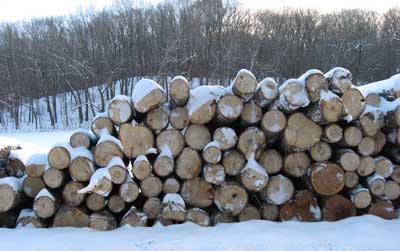Should I Harvest?
Should I harvest my trees?
Beauty, recreation, wildlife diversity: These are just some of the reasons why people own woodlands. People’s motivations are so varied, in fact, that the question of whether or not to harvest trees rarely comes down to one value, such as economics. The more appropriate question is: How does this decision relate to all my values?

Timber harvests are defined as the removal of wood fiber (i.e., trees) to accomplish one or more goals. Without a doubt, timber harvests can, and should, advance your values, as well.
Economic value: The chance to make money
Financial needs often motivate people to harvest trees, and certainly the economic value of your trees is an important factor. A typical Wisconsin woodland of 30 to 40 acres is large enough to yield periodic income through timber harvests.
And in the case of unexpected storm damage or a disease outbreak, a salvage timber harvest offers opportunity for income in an otherwise distressing situation.
To have the most successful harvest possible, it’s critical to hire a forester. These professionals ensure that the right trees are cut, and that the health of your woods is maintained and or even improved by the harvest.
The biggest advantage of working with a forester, though, is that he or she is responsible for incorporating your values into the harvest plan. This is why you should be thinking ahead of time about everything you cherish about your woods, so that these values can be honored.
Valuing beauty and the danger of “high-grading”
No doubt about it, timber harvests can create dramatic change on the land. Big, heavy trees are felled and hauled out of the woods. That’s not easy for landowners to witness, and no matter how good or bad the harvest actually looks, “ugly” sums it up for most.

As a result, those who harvest often attempt to preserve the forest’s beauty by harvesting economically valuable trees while leaving as many trees behind as possible. This approach maximizes profitability while preserving the “look” of a woods.
Everyone’s happy, right? Unfortunately, this is the definition of high-grading: logging only the best or largest trees.
In almost all cases, this type of harvesting selectively removes trees of certain species, including oak, cherry, and sugar maple, and/or the biggest and best quality trees. Left behind are smaller trees and those of lower quality form, as well as less valuable species, such as ash, red maple, elm, and hackberry – less valuable both to your pocketbook and, importantly, to wildlife.
You should thus consider it a big red flag whenever harvest decisions are based solely on maximizing economic return or are made without regard to the trees left standing or seedling regeneration.
In these cases, “preserving the look of woods” may appease your emotions, but your values were not considered, either economics or beauty. How economical is it to manage a long-term asset with a “cash out” mentality? How beautiful is a woods filled with a bunch of “leftover” species whose identity, quality, or benefit to wildlife is unclear?
Wildlife values: How harvesting can help

We’ve already stated that while timber harvests obviously help landowners achieve economic objectives, they can also be about expressing other values and realizing other goals. For example, timber harvests offer the most comprehensive and economical means to improve wildlife habitat.
Professional wildlife managers use timber harvests routinely because the dominant tree species drives the type and quality of wildlife habitat. A well-known example is aspen management. When aspen trees reach maturity, they are cut to make way for younger aspen. This is done sometimes in patches to create different age classes and habitat diversity.
These “young” woods then provide habitat for whip-poor-will, American woodcock, ruffed grouse, brown thrasher, cuckoos, many species of warblers, wild turkey, among many others.
The value of regenerating oak
Another example of how harvesting can help wildlife is the case of oak woods. Across southern Wisconsin many oak woods are converting to red maple and other types of trees as the dominant species; however, many species of wildlife – deer, turkey, and migrating songbirds among them – prefer oak as it provides much better habitat.

Oak woods also offer breeding habitat for beloved songbirds such as the Acadian flycatcher, veery, and wood thrush, as well as the blue-winged warbler, cerulean warbler, and many other warblers.
How do you keep oak as the dominant tree in your woods? A proper harvest is the best way. Make no mistake, the “take the best, leave the rest” harvest described above accelerates conversion to red maple, as invariably the “best” trees are oaks, the “rest” includes lots of red maple.
It should also be noted that the “letting nature take its course” approach to sustaining oak on your property invariably results in a forest of maple, basswood, or other non-oak species. This is because oak seedlings need full sunlight to reach sapling size. A timber harvest can create sun-drenched openings that benefit oak.
What do you value?
Many other habitat or recreation improvements are possible during timber harvests. Wildlife prefer gradual transitions between habitat types, for example. Harvesting more trees along the woods’ edge “softens” the edge.
Recreational access should be considered as logging lanes are designed. The slash from logging can be piled to create shelter and places to breed for small animals. Snags, or standing dead trees, can be created from low-quality live trees, making fantastic wildlife habitat.
The bottom line is that timber harvests should be about expressing your values and realizing your goals. How economical is a harvest that benefited your recreation and hunting? How beautiful is a harvest that creates sun-drenched gaps, giving life to the oaks you love?
